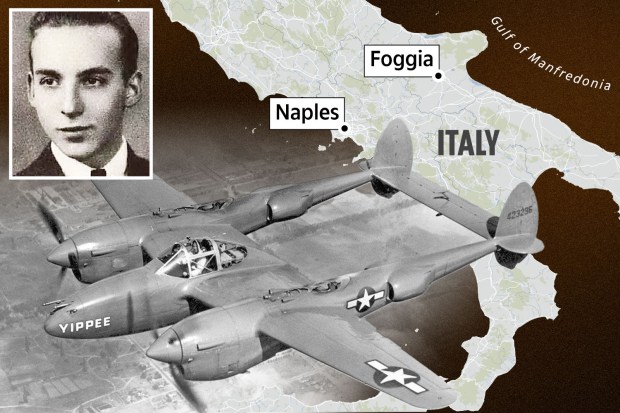Missing WWII fighter plane is found after 80 years

A fighter plane that took part in a daring raid on Italy just days before the Allies invaded has been found more than 80 years after its pilot vanished.
Warren Singer, a US airman, disappeared with his P-38 Lightning on August 25, 1943, during an attack on airfields near Foggia, Italy.
The mission hoped to delay Italy’s aerial response and was a great success – destroying 65 enemy planes.
But 2nd Lt Singer never reached his target, and Air Force records show he was last seen flying near Manfredonia, a town 22 miles east of Foggia.
Now divers have found the wreckage of Singer’s plane lying 40ft beneath the Gulf of Manfredonia.
2nd Lt Singer, who was just 22, was survived by his wife Margaret, whom he’d married five months earlier.
Margaret later gave birth to their daughter, Peggy, in January 1944, just months after he perished.
Reacting to the discovery of the plane, grandson Dave Clark said: ‘Warren is a hero to us all, and we love him.
He was a very young man with love, hope, and dreams. One of the amazing things about the story is that Warren has 12 descendants.
The diver who identified the wreck, Fabio Bisciotti, said that the plane itself was in surprisingly good condition.
He added: ‘It most likely had a mechanical failure and ditched in the water.
It was not hit hard by anti-aircraft guns because it was very far away from the coast – we are talking about four miles, more or less.
Dr Bisciotti, who leads the underwater study group at the Italian Naval League, said there was no trace of a body, meaning 2nd Lt Singer most likely escaped the wreck but later drowned.
We are all alive because of the very short time that Margaret and Warren had together. My mother recently realised there were three days between the wedding and his being shipped out.
The diver who identified the wreck, Fabio Bisciotti, said that the plane itself was in surprisingly good condition.
He added: ‘It most likely had a mechanical failure and ditched in the water.
It was not hit hard by anti-aircraft guns because it was very far away from the coast – we are talking about four miles, more or less.
Dr Bisciotti, who leads the underwater study group at the Italian Naval League, said there was no trace of a body, meaning 2nd Lt Singer most likely escaped the wreck but later drowned.
He was able to identify the wreck as a P-38 due to the plane’s distinctive twin-boom design and narrowed it down to 2nd Lt Singer’s aircraft since records show it was the only P-38 lost at sea in the area.
P-38 National Association historian Steve Blake recounted the circumstances of 2nd Lt Singer’s disappearance.
He said 166 P-38s had taken off from Tunisia that day – 137 planes reached their target, others turned back due to various mechanical problems, and one vanished altogether – 2nd Lt Singer’s plane.
The report said ‘the last seen of Singer’ was when he had ‘turned back to be with Lt Hendrix at the coast.
Another comrade, his best man Fred Selle, recalled that 2nd Lt Singer had flown alongside him and signalled that he too was struggling to jettison his tanks, before turning back.
2nd Lt Singer, who was a second-year student at the University of Illinois Urbana-Champaign, was declared dead on August 26, 1944.
Although Italy and the US were at war when he died, Dr Bisciotti said it was a ‘big honour’ to identify his plane.
He said: ‘It’s important to remember that we are talking about a human being; that he believed in what he was doing, so enemy or friend it doesn’t matter, he must be honoured.




